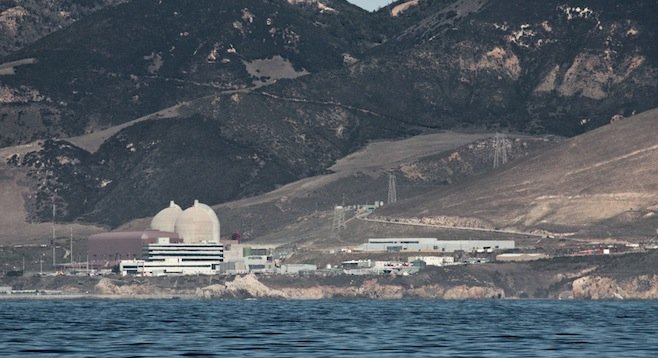 Facebook
Facebook
 X
X
 Instagram
Instagram
 TikTok
TikTok
 Youtube
Youtube

Parallel narratives between the defunct San Onofre Nuclear Generating Station and Diablo Canyon, the state's last operational nuclear power plant, are continuing to emerge.
Back in 2010, the lights were still on at San Onofre and plant operators were facing a hurdle in their quest to extend the facility's operating license — the discovery of previously unknown earthquake fault lines, some running close to the plant.
Diablo Canyon's operator, Pacific Gas & Electric, may face a similar situation as the company petitions energy officials for permission to continue operating beyond the twin reactors' current permit expirations in 2024 and 2025. The environmental watchdog group Alliance for Nuclear Responsibility is crying foul on the utility's handling of seismic reports that were done as a part of the license extension process.
The Alliance accuses PG&E in a California Public Utilities Commission filing of an "attempt to subvert the oversight of a state sanctioned independent review panel, which PG&E successfully dodged with a trumpeted submittal of its 'final' seismic study to the [federal Nuclear Regulatory Commission, which handles licensing] before the peer review panel had even been shown the results."
State Assembly Bill 1632, passed in 2006, calls for seismic studies at all major power plants within the state, which resulted in a specific recommendation for the use of "three‐dimensional geophysical seismic reflection mapping and other advanced techniques to explore fault zones near Diablo Canyon.” Results were then to be submitted to an independent review panel, but, the Alliance says, PG&E instead stamped their own findings as "final" and sent them along to the NRC without initiating the peer review process.
"Without independent review, this report is propaganda, not science," says Alliance attorney John Geesman.
A release accompanying the group's filing implies PG&E's relation with the review panel has been contentious for some time, noting that scheduled quarterly meetings have not taken place since July 2013, and quoted internal e-mails from the company express a desire to "get the [independent peer review panel] 'decommissioned.'"
"PG&E chose to finalize its entire report and release it to the public before it sought any comment from — or even contacted — the peer review panel. It appears to me that PG&E’s public relations staff advised them to get their story to the public before any detailed questions might be asked," adds review panel member San Luis Obispo county supervisor Dr. Bruce Gibson.
The Alliance, noting that incomplete seismic testing pushed the plant's initial cost up by $4 billion (the plant's twin reactors were originally projected to cost less than $1 billion in total to bring online), wants the utility to explain why it abandoned "offshore high energy underwater seismic surveys of Diablo" and why it didn't "notify the NRC immediately, as required, when early results revealed that the Shoreline fault could rupture jointly with the Hosgri fault, causing higher ground motions than previously reported to the NRC."


Parallel narratives between the defunct San Onofre Nuclear Generating Station and Diablo Canyon, the state's last operational nuclear power plant, are continuing to emerge.
Back in 2010, the lights were still on at San Onofre and plant operators were facing a hurdle in their quest to extend the facility's operating license — the discovery of previously unknown earthquake fault lines, some running close to the plant.
Diablo Canyon's operator, Pacific Gas & Electric, may face a similar situation as the company petitions energy officials for permission to continue operating beyond the twin reactors' current permit expirations in 2024 and 2025. The environmental watchdog group Alliance for Nuclear Responsibility is crying foul on the utility's handling of seismic reports that were done as a part of the license extension process.
The Alliance accuses PG&E in a California Public Utilities Commission filing of an "attempt to subvert the oversight of a state sanctioned independent review panel, which PG&E successfully dodged with a trumpeted submittal of its 'final' seismic study to the [federal Nuclear Regulatory Commission, which handles licensing] before the peer review panel had even been shown the results."
State Assembly Bill 1632, passed in 2006, calls for seismic studies at all major power plants within the state, which resulted in a specific recommendation for the use of "three‐dimensional geophysical seismic reflection mapping and other advanced techniques to explore fault zones near Diablo Canyon.” Results were then to be submitted to an independent review panel, but, the Alliance says, PG&E instead stamped their own findings as "final" and sent them along to the NRC without initiating the peer review process.
"Without independent review, this report is propaganda, not science," says Alliance attorney John Geesman.
A release accompanying the group's filing implies PG&E's relation with the review panel has been contentious for some time, noting that scheduled quarterly meetings have not taken place since July 2013, and quoted internal e-mails from the company express a desire to "get the [independent peer review panel] 'decommissioned.'"
"PG&E chose to finalize its entire report and release it to the public before it sought any comment from — or even contacted — the peer review panel. It appears to me that PG&E’s public relations staff advised them to get their story to the public before any detailed questions might be asked," adds review panel member San Luis Obispo county supervisor Dr. Bruce Gibson.
The Alliance, noting that incomplete seismic testing pushed the plant's initial cost up by $4 billion (the plant's twin reactors were originally projected to cost less than $1 billion in total to bring online), wants the utility to explain why it abandoned "offshore high energy underwater seismic surveys of Diablo" and why it didn't "notify the NRC immediately, as required, when early results revealed that the Shoreline fault could rupture jointly with the Hosgri fault, causing higher ground motions than previously reported to the NRC."
Comments